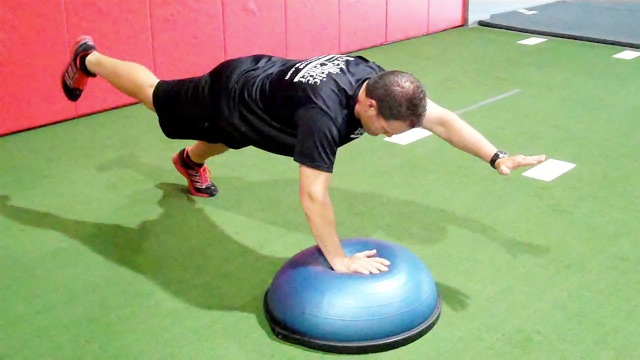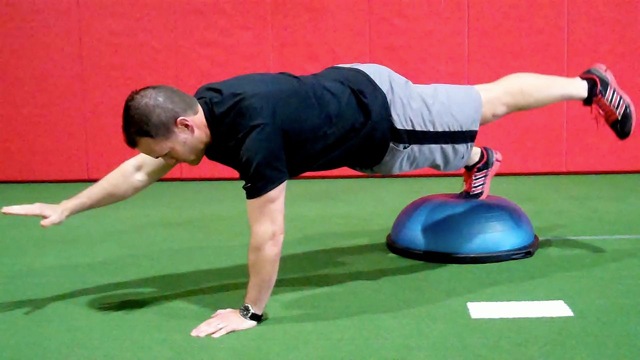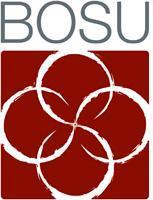
Execution:
For the unstable upper extremity pattern, position the right hand on the BOSU Balance Trainer with the left hand on flat on the floor (push-up position with near full elbow extension). The feet should be placed 8-12 inches apart. Be sure to retract the cervical spine (packing the neck so to speak) and maintain a neutral spine angle.
 Keeping the body still and the core tight, slowly raise the left hand off the floor moving into shoulder flexion while simultaneously lifting the the right leg up into extension. Pause at the top for 2-5 seconds and then slowly lower the hand and foot back down to the floor. Keeping the body still and the core tight, slowly raise the left hand off the floor moving into shoulder flexion while simultaneously lifting the the right leg up into extension. Pause at the top for 2-5 seconds and then slowly lower the hand and foot back down to the floor. | |
 | The other version would involve moving the BOSU Balance Trainer beneath the right foot (toes). Utilize the same alternate arm and leg sequence as before. Due to the high level of difficulty, I suggest focusing on only the range of movement the client can control and aiming for a quality isometric hold at the end of that motion before lowering back down. |
This is an exhausting maneuver. Therefore, I suggest performing 1-3 sets of 5-6 repetitions on each side. Quality of the movement along with proper alignment and stability should be the primary focus. The speed of movement should be slower and deliberate.
Application:
These exercises are intended for advanced users who want or need to challenge shoulder, core and hip stability. In my experience, there may only be a small percentage of clients who can move to this level of difficulty, so layering the exercise with progressions and regressions listed below is recommended:
1. Quadruped alternate arm raises (floor)
2. Quadruped alternate leg raises (floor)
3. Quadruped alternate arm/leg raises (Bird Dog on floor)
4. Four point alternate arm raises (hands and toes on floor)
5. Four point alternate leg raises (hands and toes on floor)
6. Four point alternate arm and leg raises (alternating sides each repetition with hands and toes on floor)
7. Four point alternate arm and leg raises with holds performing consecutive reps on the same side (hands and toes on floor)
The core must function in an anti-extension and anti-rotation fashion throughout which is a very effective way to target those muscles while also providing a demanding challenge for the entire upper and lower kinetic chain. Loss of form is the key to determining the number of sets, reps, length of hold and proper step in the regression or progression.
The exercise will also help clients train hip stability/mobility through the coupled flexion/extension moments. I employ this type of training for many of my athletes who are in need of spiral line work and added stability training.
Precautions:
Sufficient upper body strength is a must for this exercise. Clients with wrist pain/weakness/injury, elbow and shoulder pathology or active hip injuries should only perform this exercise provided they have are symptom free and have moved the previous progression symptom free with satisfactory form.
Depending on the surface, it is also advisable to spot in such a way that you can prevent the BOSU Balance Trainer from moving suddenly should the client lose balance unexpectedly. I strongly encourage performing this exercise early in a session when clients are less fatigued to maximize the neuromuscular training benefits.
Brian Schiff, PT, CSCS, is a licensed physical therapist, respected author and fitness professional. Currently, he serves as the supervisor at the Athletic Performance Center in Raleigh, NC. Brian presents nationally at several professional conferences and seminars on injury prevention, rehab and sport-specific training. For more cutting edge training information, subscribe to his monthly Training & Sports Medicine Update at www.BrianSchiff.com.



















